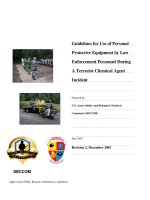Mastering macro photography ideas, tips, tutorials DIY equipment by jason miller
Bạn đang xem bản rút gọn của tài liệu. Xem và tải ngay bản đầy đủ của tài liệu tại đây (3.15 MB, 169 trang )
Mastering
MacroPhotography
Ideas,Tips,Tutorials&DIYEquipment
Publishedby:
www.seeinginmacro.com
Copyright©2014.Allrightsreserveworldwide.Nopartofthispublicationmaybe
replicated,redistributed,orgivenawayinanyformwithoutthepriorwrittenconsentof
theauthor/publisher.
TableofContents
1.WhatisMacroPhotography?
2.IsMacroPhotographyDifferenttoClose-UpPhotography?
3.WhatisMagnificationRatio?
4.HowtoCalculateYourMagnificationRatio
5.WhatTypeofMacroPhotographerAreYou?
6.WhatYouNeedToConsiderBeforePressingtheShutterButton
TheImportanceofDepthofFieldinMacroPhotography
HowtoControlDepthofField
TheImportanceofColorHarmonyinMacroPhotography
HowtoAchieveColorHarmonyinYourMacroPhotos
IntroducingtheColorWheel
UsingMonochromaticColors
UsingAnalogousColors
UsingComplementaryColors
UsingTriadicColors
TheImportanceofCompositioninMacroPhotography
UnderstandingandApplyingCompositionRules
TheRuleofThirds
CleanBackground
AUniquePerspective
UsingDiagonalLines
PerceptionofMovement
Patterns
Texture
Framing
7.ShouldYouBeaRuleBreaker?
8.WhatMacroPhotographyEquipmentDoYouNeed?
WhatCameraDoYouNeed?
HowtoChooseaCamera
WhatLensDoYouNeed?
HowtoChooseaLens
WhatareExtensionTubes?
HowtoChooseaSetofExtensionTubes
WhatisaLensReversalRingAdapter?
HowtoChooseaLensReversalRingAdapter
WhatareClose-UpFilters/Diopters?
HowtoChooseaLensDiopter/CloseUpFilter
WhatareBellows?
HowtoChooseBellows
WhatareFlashUnits(Built-In,Hot-Shoe,Ring&Dual)?
HowtoChooseaMacroRingLight/Flash
WhatisaFlashDiffuser?
HowtoChooseaFlashDiffuser
WhatisaTripod?
HowtoChooseaTripod
WhatisaMacroFocusingRail?
HowtoChooseaMacroFocusingRail
9.ComparingtheClose-UpFilter,ReversingLensAdapter,ExtensionTubes&
DifferentCombinations
50mmLensOnly
50mmLenswithClose-UpFilters
50mmReversedLens
50mmLenswithFullSetExtensionTubes
50mmReversedLenswithFullSetExtensionTubes
10.SoWhatEquipmentDoYouREALLYNeed?
11.MacroPhotographyonaBudget–DIYMacroPhotographyEquipment
HowtoMakeaStringTripod
HowtoMakeaFlashDiffuser
HowtoMakeaLightBox/MiniStudio
HowtoMakeaMacroRingLight
HowtoMakeaMacroExtensionTube
12.EasyTipstoSaveMoneytoPurchasetheBestMacroPhotographyGear
13.UnderstandingCommonIssuesInMacroPhotography
HowtoIdentifyandFixBlurryPhotosfromCameraShake
HowtoIdentifyandFixBlurryPhotosfromIncorrectFocusPoint
HowtoIdentifyandFixBlurryPhotosfromSubjectMovement
HowtoIdentifyandFixBlurryBackgroundPhotos
14.HowtoKissBlurryPhotosGoodbye
15.MacroPhotographyTechnique–FocusStacking
WhatisFocusStacking?
WhyUseFocusStackinginMacroPhotography?
Indoorsvs.OutdoorsFocusStacking
WhatEquipmentIsTypicallyUsedForFocusStacking?
16.HowtoFocusStack(Indoor)Tutorial
Step-by-StepFocusStackingTutorial
TipsandAdviceforBetterStackedPhotos
17.PracticalMacroPhotographyTipsandTricks
HowToPhotographInsects/Bugs
HowtoPhotographFlowers&Plants
18.WheretoFindMacroPhotographySubjectsWhenThereAreNoneAroundYou
19.HowtoMakeYourGardenaMacroPhotographySubjectMagnet
HowtoAttractButterflies
HowtoAttractOtherInterestingInsects
20.UniqueMacroPhotographyIdeas&Tutorials
PhotographingBubblesTutorial
AbstractOilandWaterIdeaTutorial
BubblesandWaterTutorial
BubblingSlicedFruitinWaterTutorial
InkInWaterTutorial
DewDropsonSpiderWebTutorial
WaterDropPhotographyTutorial
AbstractReflectionsinWaterDropletsTutorial
WaterDropletfromFaucetTutorial
21.DevelopingTheMacroPhotographer’sMindset
HowtoBecomeaBetterMacroPhotographer
YourFirst10,000PhotographsareyourWorst…
ShouldYouPrintYourDigitalMacroPhotos?
22.FinalWords–Bonus&OtherPhotographyResources
23.Credits
1. WhatisMacroPhotography?
Macrophotographyisoneofthemostchallengingformsofphotography.Itopensupa
wholenewworldforphotographerstoexploreandencouragesthemtoseetheworldwith
adifferentperspective.Ifwehadtodefine‘macrophotography’,wewouldsaythatitis
theartofmakingsmallobjectslookbig.Itisaboutbringingoutthebeautyintheobjects
thatweoftentakeforgrantedinourdailylives
Whilsttheworldofmacrophotographyistypicallyassociatedtoimagesofinsects,
flowersandplants,macrophotographersarenotlimitedtothesesubjectsonly.Whenyou
stepintothemacrophotographyworld,youwillsoondiscoverthatthereisanothersideto
macrophotography–onethatisabstractandcreative.
Thiscouldinvolvecapturingtheexcitingtexturesandpatternsofanobjectandturningthe
smalldetailsoftheobjectintothefocusofattention.Forexample,thetextureofasliced
fruitorthepatternsonabutterflywingoreventhewrinklesonaperson.
Beforeyoustartyourmacrophotographyjourney,wemustwarnyoufirst–macro
photographyisextremelyaddictive.Youwillbelockedintoalifelongjourneyoflearning
andyouwillbeconstantlyhoningyourphotographer’seye,patienceandperseverance.
Sowewishyouthebestofluckandhopethatyouwillenjoythejourney-itisgoingtobe
anexcitingandrewardingone!
Image1-WhatisMacroPhotography?
2. IsMacroPhotographyDifferenttoCloseUpPhotography?
Upuntilnow,wehaveintentionallysteeredclearofthetechnicaldefinitionof‘macro
photography’toavoidputtingyoutosleep.Itisnotaninterestingtopictocoversowewill
trytomakethisaspainlessaspossibleforyou.
Inthemacrophotographyworld,youwillhearmanydebatesonthedifferencesbetween
macrophotographyandcloseupphotography.Itisahottopicandmorethanlikely,you
willbesuckedintothisdebateatsomepointinyourjourney.
Itisimportanttokeepinthebackofyourmindthedifferencesbetweenmacro
photographyandcloseupphotography.Thesephotosmaylookverysimilartoyou
howeverwhenwestarttodrilldownintothetechnicalcomponents,theyareactually
different.
Macrophotographygenerallyrequiresa1:1orhighermagnificationratiobetweenthe
objectimagethatyouarephotographingandtherealobject.Whatthismeansisthatifyou
arephotographingabeethatis1inchinsize,thisbeewillappearas1inchorgreateron
yourcamera’ssensor.Iftheobjectimageissmallerthantherealobject,thiswillthenbe
categorizedascloseupphotography.
Whetheryouachievethemagnificationratioof1:1orhigherisgoingtobedependenton
thephotographyequipmentthatyouuse.Wewillcoverthisinalaterchapter.
Sodoesitreallymatter?Forus-No.Butforsomeotherpeople-Yes.Inthisbook,we
willbeusingthetermsinterchangeably.Whileitisimportanttoknowthetechnical
differencesbetweenmacrophotographyandcloseupphotography,webelievethatitisfar
moreimportantforaphotographertogetoutinthefield,shoot,learnandenjoy
themselves.
So,don’tletthe‘macrophotographyorcloseupphotography’debatesconfuseyouorstop
youfromenteringthemacrophotographyworld.
Image2-MacroPhotographyvsClose-Up
3. WhatisMagnificationRatio?
Manypeopledonotfullyunderstandwhat‘magnificationratio’meansandmorethan
often,itcanbequiteconfusingaswell.Sotomakesureyouhaveagoodgraspofit,we
wantedtocover‘magnificationratio’inalittlemoredetailandthenteachyouasimple
methodtodeterminethemagnificationratioofyourownequipment.It’llbequick,easy
andfun.
Macrophotographersarealwayskeentoknowwhat‘magnificationratio’thattheyare
achievingwiththeirequipmentbecauseahighermagnificationratiowillultimatelyallow
themtoobtaincloserphotosoftheirphotographysubjects.Moreimportantly,after
learningaboutthewaytocalculateyourmagnificationratio,youwillthenbeableto
speaktoothermacrophotographersandtellthemaboutthemagnificationratioofyour
equipment!
Sowhatdoesamagnificationratioof1:1mean?Tore-capwhatwesaidpreviously,this
basicallymeansthatwhenyoutakeaphotoofabutterfly,theprojectedimageofthe
butterflyonthecamera’ssensorwillbetheactualsizeofthebutterfly.
Tohelpusunderstandthis,let’sassociatesomenumberstotheexamples.Letusassume
thatthecamera’ssensoris26mminlength.When26mmoftheactualimageisprojected
ontothecamera’s26mmsensor,thenthisresultsinamagnificationratioof1:1.When
52mmoftheactualimageissqueezedintofitontothecamera’s26mmsensor,thenthis
resultsinamagnificationratioof1:2.Thismeansthatyouractualimage
size/magnificationhasbeenreducedtohalf.When13mmoftheactualimageisprojected
ontothecamera’s26mmsensor,thenthisresultsinamagnificationratioof2:1.This
ultimatelymeansthatyouractualimagehasdoubledinsize.
4. HowtoCalculateYourMagnificationRatio
Thereareanumberofdifferentwaystocalculateyourmagnificationratio.Somepeople
willsuggestusingasimplemathformulatocalculatethemagnificationratio.However,
youneedtobeawarethattheformulahaveitslimitationsanddonotalwaysworkfor
everytypeofmacrophotographyequipmentsetup.Themathformulamethodhas
confusedmanypeopleinthepastandassuchwehavechosennottocoverthismethodin
thisbook.
Instead,wearesharingthishands-onmethodofcalculatingyourmagnificationratiofor
yourmacrophotographysetup.Itwillworkforeverysimpleorcomplexmacrogearsetup
youhave.Itisextremelyfunandyoucanreallyseeandmeasurethemagnificationchange
rightinfrontofyoureyes!
WhatisRequired?
Camera
Ruler
Lengthsizeofyourcamera’ssensor(Youcaneasilyobtainthisfromthe
manufacturer’swebsite–orjustGoogleyourcameramodel+‘sensorsize’.eg.Nikon
D80sensorsize)
TutorialSteps
1. Layyourruleronaflatsurfaceandhaveyourcameraverticallyaboveit.
2. Aimattherulerandtrytolocatetheclosestheightwhereyoucanstillfocusontothe
ruler.Youwillneedtomoveyourcameraclosertotherulerwhiletryingtofocusonto
theruler.Therewillbeapointwhereyouwilljustnotbeabletofocusontheruler
anymore.Youwanttolocatethepointrightbeforethathappens.
3. Whenyouhavelocatedthelastpointwheretherulerisstillinfocus,takeaphotoof
themeasurementontheruler.
4. Lookatyourphotoandcounthowmanymillimeter(mm)oftheruleriscontained
withinthephoto
5. Comparethatmeasurementtothelengthsizeofyourcamera’ssensor.Forexample,
thesensorsizeonthemanufacturer’swebsitemaybe37mm(length)x24mm(width)
andthephotooftherulershowsapproximately37mminlength.Thismeansthatyou
have1:1magnificationratio(lifesize).Ifthephotooftherulershowsapproximately
18.5mm,thenyouhave2:1magnificationratio(twicethelifesize).
Usethefollowingformulatohelpyoucalculatethemagnificationratio–
Magnification=SensorWidth/#ofmmcapturedinyourphoto
Hands-onExample
Photographofarulerwithamacrolens–Approximately37mminlength.
FirstScenario
Equipment–
NikonD700
Nikkor105mmf2.8macrolens
Image3-Photographofarulerwithamacrolens.Approximately37mminlength.
Theabovephotowascapturedwithamacrolensonly.Applyingourformulaof–
Magnification=SensorWidth/#ofmmcapturedinyourphoto
Magnification=37mm/37mm=1
Thereforeanapproximatemagnificationratioof1:1.
SecondScenario
Equipment–
NikonD700
Nikkor105mmf2.8macrolens
68mmofextensiontubes
Image4-Photographofarulerwithamacrolens+68mmextensiontubes.Approximately17mminlength.
Theabovephotowascapturedwithamacrolensand68mmofextensiontubes.Applying
ourformula–
Magnification=SensorWidth/#ofmmcapturedinyourphoto
Magnification=37mm/17mm=2.17
Thereforeanapproximatemagnificationratioof2:1
Aftercompletingthishands-ontask,youshouldhaveanideaofwhetheryouareactually
shootingin‘macro’ornot.Ifyouarenotachievingaratioof1:1,that’sOK!Don’tstress–
therearesomanyotherwaystogetyouclosertothe1:1ratio.Wewillsharesomeof
theselesserknownsecretswithyouintheequipmentchapter.
Asalways…Don’tforgetthatitismoreimportanttogetoutthere,learnaboutyour
cameraandenhanceyourmacrophotographyknowledgeandtechniquesratherthan
worryingaboutyourmagnificationratio.
5. WhatTypeofMacroPhotographerAre
You?
Beforeyoustartyourmacrophotographyjourney,youshouldtakeafewmomentsto
considerwhattypeofmacrophotographeryouare.Thismaysoundsillyatfirst,butthis
willhelpyoutodeterminethetypeofphotosthatyoushouldtakeandthephotography
techniquesthatyouwillneedtouse.
Thesearethetwotypesofmacrophotographers–
1. Scientificmacrophotographer
2. Creativemacrophotographer
ScientificMacroPhotographer
Macrophotographyforscientificpurposesisverydifferenttocreativemacrophotography.
Asascientificmacrophotographer,themainpurposeofyourphotoistodocumentthe
event,fauna(insects,animals,etc)orflora(flowers,plants,etc).Forexample,youmaybe
photographingallthedifferentbutterflyspeciesinyourgeographiclocation.Therefore,
theprimarypurposeofyourphotoistosupportyouorascientistinidentifyingeachofthe
speciestype.
Asascientificmacrophotographer,youshouldtrytoachievethefollowinginyourphotos
–
Includetheenvironment/surroundingsalongwithyoursubject.Youdonotneedto
worryaboutbackgroundclutter.
Useasmallaperture(eg.f/16)toachieveadeepfieldofdepth.Thiswillensurethat
yoursubjectandthesurroundingsareinfocus.
Capturethesubjectatthecorrectanglesothatitcanbeusedforidentification
purposes.Itisimportantforyoutolearnaboutyoursubjectbeforehandsothatyou
knowtheangleortheanatomythatcoulduniquelyidentifythesubject.Forexample,it
maybeaspecificpatternorcolorthatisonyoursubjectthatwillidentifyit
Useyourflashtofreezemotion.
Avoidanypost-processingofyourphoto.Donotenhanceoraltertheoriginalphotoas
animperfectiononyoursubjectcouldtellawholedifferentstory.
CreativeMacroPhotographer
Whenitcomestocreativemacrophotography,thesemacrophotosusuallyhaveanartistic
elementtothem.Thisiswhatmakescreativemacrophotographysointeresting.Aphoto
ofthesamesubjectcouldbetakeninsomanydifferentwaysandcouldlookverydifferent
eachtimeaphotoistaken.
Increatingacreativemacrophoto,thephotographerwilltakeanumberofdifferent
factorsintoconsideration.Wewillcoversomeofthesetechniquesinmoredetailinthe
nextchapter,however,asasneakpeek,thefollowingaresomeofthethingsthatare
usuallyconsideredbeforetheshutterbuttonispressed–
Depthoffield
Composition
ColorHarmony
Lighting
6. WhatYouNeedToConsiderBefore
PressingtheShutterButton
TheImportanceofDepthofFieldinMacroPhotography
Asamacrophotographer,itisveryimportanttounderstandwhatdepthoffieldisandhow
itcanaffectyourphotos.Thedepthoffieldtechniquehasbeenusedinmacro
photographyformanyyears.Depthoffieldisthedistancebetweenthenearestand
farthestobjectsinascenethatappearacceptablysharpinanimage.
Whentalkingaboutdepthoffield,peoplewillgenerallyusetwodifferenttermsto
describeyourphoto–
1. Narrow/Shallowdepthoffield
2. Wide/Deepdepthoffield
Bycomposingaphotothathasashallowdepthoffield,theareaswithintheimagewillbe
lessinfocus.Thiswilldrawaviewer’sattentiontoaspecificareaofthephotothatisstill
infocus.Althoughitisnottoocommonincreativemacrophotography,aphotographer
couldalsoadjustthecamerasettingstoachieveadeepdepthoffield.Thiswillresultin
photothatislikelytohavemoreareasthataremoreinfocus.
Image5-ImportanceofDepthofField
HowtoControlDepthofField
Sohowdoyoucontrolthedepthoffieldinyourphoto?Thereareanumberofwaysand
thisincludesthefollowingAperture
FocalLength
CameraDistancefromsubject
Aperture
Apertureisoneofthefactorsthatwillaffectthedepthoffieldinyourimage.Apertureis
thesizeoftheopeninginyourlens.Generally,whenusingalargerapertureorsmaller
f/stopnumber(eg.F2.8),yourimagewillbelessinfocus(eg.shallowdepthoffield).
Whenyouuseasmallerapertureoralargerf/stopnumber(eg.F22),yourimagewill
becomemoreinfocus(eg.deepdepthoffield).
FocalLength
Focallengthistheotherfactorthatwillaffectthedepthoffieldinyourimage.Thelonger
yourfocallength(eg.alenszoomedto100mm),thelessareasofyourimagewillbein
focus(shallowdepthoffield).Ontheotherhand,ifyouuseawiderfocallength(alens
zoomedoutto24mm),moreareasofyourimagewillbeinfocus.
CameraDistancefromSubject
Thedistancebetweenyoursubjectandcamerawillalsoaffectthedepthoffieldinyour
image.Generally,thecloseryouaretoyoursubject,thelessofyourimagewillbein
focus(shallowdepthoffield).Ifyouthenmovefurtherawayfromyoursubject,youwill
noticethattheimagewillbecomemoreinfocus(deepdepthoffield).
Whenconsideringthedepthoffieldinyourphotos,thereisnohardandfastruleinmacro
photographythatstatesthatyourimagesshouldhaveashallowdepthoffieldoradeep
depthoffield.Attheendoftheday,itcomesdowntothecompositionthatyouareafter
asaphotographer.Youjustneedtobeawarethatdifferentdepthoffieldwithinanimage
willtellacompletelydifferentstorytoyourviewers.
TheImportanceofColorHarmonyinMacroPhotography
Colorsplayanimportantroleinyourphotos.Asyouknow,thehumaneyecanseeand
processawidespectrumofcolors.Evenwithoutanyformaleducationinartsordesign,
thehumaneyeandbraincan‘sense’whetherspecificcombinationofcolorswillwork
together.
Insteadofrelyingpurelyonyoursensestodeterminewhethercolorswillworktogetheror
not,wewanttoequipyouwithsomebasiccolortheoriessothatyouknowhowtoachieve
‘colorharmony’inyourmacrophotos.Whenwetalkaboutcolorharmony,weare
referringtothesetofcolorsthatwillworkharmoniouslytogethertoachieveanimagethat
ispleasingtotheeye.Thesearethetypeofphotosthatyoushouldstrivetocapture.
HowtoAchieveColorHarmonyinYourMacroPhotos
IntroducingtheColorWheel
ThecolorwheelwasinventedbyIsaacNewtonanditisatoolthatwillhelpyouto
determinewhethercolorsareinharmony.Withoutboringyouwithallthedetailsofthe
colorwheel,whatIwantyoutorememberisthattherearethreeprimarycolors–Red,
YellowandBlue.Whenyoustarttoadddifferentmixturesoftheseprimarycolors
together,thiswillresultinthecreationofanewcolor.Thesecolorsareknownas
secondarycolors.Forexample,addingmoreyellowtoredwillhelptoachievetheorange
color.Whenyoumixtheprimarycolorwiththesecondarycolor,itwillthenresultinthe
creationofanothernewcolor.Thesenewcolorsarecalledtertiarycolors.
Image6-TheColorWheel
UsingMonochromaticColors
Thefirstwaytoachievecolorharmonyisthroughtheuseofmonochromaticcolors.Don’t
letthebiglongwordscareyou.‘Mono’basicallymeans‘Single’or‘One’and‘Chromatic’
means‘Color’.Assuch,toachievemonochromaticcolorsinyourphoto,youwilluse
differenttones,tintsandshadesofasinglecolor.
Thecolorwheelcanhelpyoutoachievemonochromaticcolors.First,youwillneedto
selectacolorfromthecolorwheel.Nextyouwillneedtoaddmoreblack,whiteorgrey
colortoyourchosencolor.Byusingacombinationofthesecolors,youwillachieve
monochromaticcolors.
Aphotocreatedwithmonochromaticcolorswillcreateavisuallyappealingimagethatis
balanced.However,thephotowilllackcolorcontrast.
Image7-MonochromaticColorsonColorWheel
Image8-MonochromaticColorExample
UsingAnalogousColors
Thesecondwaytoachievecolorharmonyisthroughtheuseofanalogouscolors.Once
againdonotbeintimidatedbytheterm.‘Analogouscolors’relatestotheselectionofa
groupofcolorsthataresimilarandblendwelltogether.
Thecolorwheelcanhelpyoutoselectyouranalogouscolors.Toachievethis,youmust
firstselectthemaincolorfromthecolorwheel.Youwillthenneedtoselect2adjacent
colorstothemaincolor.Youcanselectonecoloroneithersideor2colorsfromoneside
ofthemaincolor.
Asmacrophotographers,wearequitelucky.Analogouscolorsappeareverywherein
nature.Ifyouthinkabouttheleavesonthetreesduringtheearlyautumnseason,youwill
noticethattheleavesareamixtureofgreen,yellowandredcolors.
Aphotocreatedwithanalogouscolorswillresultinanimagethatisricherthanthe
monochromaticcolors.However,itmaysometimesnotlookasvibrantasitstilllacks
colorcontrast.









